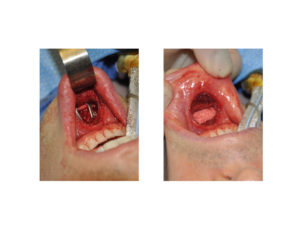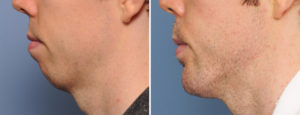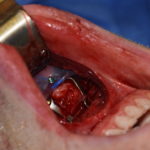Background: Routine chin deficiencies are well managed by with an implant or a sliding genioplasty. The concept of a routine chin augmentation, in my experience, generally falls into a horizontal chin position movement of 10mms for less. Once the aesthetic need becomes greater than a centimeter there is undoubtably an overall lower jaw skeletal deficiency that should ideally managed by a combined orthodontic-orthognathic surgery approach.
But some lower jaw deficient patients will never undergo movement of the entire lower jaw and teeth positions for a variety of reasons. They may appear just for chin augmentation only as a camouflage approach to their lower facial deficiency.
While a large chin implant can be used, most standard chin implants do not provide more than 10mms of horizontal advancement. While larger custom chin implants can be made, such a load of synthetic material on the chin may exceed the soft tissue stretch to safely accommodate it. The projection off such a large chin implant may also appear unnatural with a much thinner jawline behind it.
A sliding genioplasty can usually exceed 10mms if the bone thickness will allow it. I have seen it often go to 14 to 16mms. But in such large tiny chin movements there will be pronounced stepoffs on their sides and the labiomental fold will definitely get much deeper as the bone underneath it has become deeper as the lower chin point comes forward.
Case Study: This young male has a large chin deficiency with a skeletally short lower jaw. From an ideal chin projection standpoint for a male (vertical line dropped down from the lips) he was 22mms horizontally short. Orthognathic surgery was not an option that he wanted to pursue.


It is not a mortal surgical sin to combine two chin augmentation methods that are often viewed as competitive procedures. Each has their own distinct aesthetic effects and in rare cases may be used synergistically to create a better aesthetic outcome than either one can achieve alone.
Highlights:
- Large chin deficiencies are often beyond what a sliding genioplasty or a chin implant can effectively treat alone.
- Combining a sliding genioplaty with a chin implant can maximize the amount of horizontal advancement and cover bony step offs on the sides.
- Large sliding genioplasty movements will require fill of the step-off to avoid a severe deepening of the labiomental fold.
Dr. Barry Eppley
Indianapolis, Indiana



